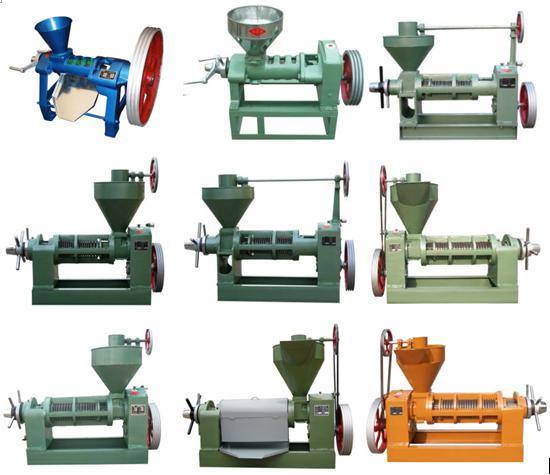What kinds of impurities can be removed by cooking edible oil refining machine?
Cooking edible oils are an essential ingredient for human diet. No food worth taste could be prepared without use of cooking edible oils. Depending on Geographical locations different varieties of oils are popular in different region. Nature has given distinct individual characteristics to all cooking edible oils.
The simplest and age-old method of obtaining edible vegetable oil has been simple mechanical extraction. The oil is squeezed out from oil seeds by applying mechanical pressure. The common equipment used now a daysis Screw Press.

Small scale screw press machine
Peanuts i.e. Ground Nuts, Copra, Sunflower Seed, Palm Kernal, Canola seed i.e. rape seed or mustards seed yields major oil through screw presses and in majority of the cases the oil obtained can be and is being used directly as edible oil.
However to recover the left over oil after mechanical extraction from prepressed cakes and for recovery of oil from low oil content seeds like soyabean, cotton seed etc., Solvent Extraction (Solvent Extractions, com ) is process adopted.
Since normal Hexane a petroleum bye product is used to extract the oil, refining of oil is compulsory before using it for human consumption.

Cooking edible oil solvent extraction process machinery
Basically cooking edible oil has following impurities which needs to be removed.
1) PHYSICAL IMPURITIES:
Left over particles of oil seeds etc. By simple filteration process these impurities are removed.
2) PHOSPHATIDES, GUMS AND WAXES:
During pretreatment process gums and other impurities are either separated out, either through batch degumming or through continuous process with help of centrifugal separators. When impurities are only in small quantities Gum conditioning process is adopted, where in gums are just precipitated and are removed in next neutralising process.
3) FREE FATTY ACIDS:
Popularly known as F.F.A. all vegetable oils are compound formed by Glycerin and Fatty Acids when Fatty Acid separates out from the bond with Glycerin they are termed as Free Fatty Acids. The free Fatty Acids are generally removed by neutralising them with alkalies like caustic soda. The soap stock formed and the oil are then separated out by decantation process in Batch Neutralising or by centrifuge separation in continuous Neutralising.
4) COLOURING PIGMENTS:
Depending on the quantity and type of colour pigments present in the oil, oils have colour ranging from light yellow, reddish} to dark brownish (as in crude cotton seed oil). To give uniform, colour it is essential to bleach the oil with the help of bleaching agents like bleaching earth / activated carbon. Bleaching agents absorbs the colouring pigments. By filteration process the spent bleaching agent is filtered out. Sometimes caustic treatment in neutralising section also reduces the colour of oil specifically in cotton seed oil. In case of palm oil colour is also reduced by heat treatment. Bleaching operation is performed either as batch process in smaller capacities or as continuous operation in large capacity plants.
5) ODOUR:
Every oil has its own district odour sometimes pleasing odour sometimes unpleasant odour. Neutralising and bleaching process also adds odour to the oil which is unpleasant. It is therefore essential to remove the odour from oil. Deodorisation is the process to remove odiferous matter from vegetable oils. The odour is removed by injecting open steam in the oil which is heated to high temperature and kept under high temperature and kept under high vacuum. The odiferous matter distills off at high temperature and high vacuum and is carried away through vacuum system. The oils is cooled.
6) WAXES:
Some oil like sunflower seed oil and maize germ (corn) oil have waxes present in them. At low temperature waxes appears and gives hazy appearance to oil. Consumer does not prefer such hazy appearance.
Dewaxing process is adopted for separation of waxes from oil. Oil is cooled and chilled in crystallisers the waxes are crystallized. The wax crystals are separated out either by cold neutralization in centrifuges or more common method of separation is filter them out in horizontal pressure leaf filters.
The oils which is thus treated for removal of gums, free fatty acids, colouring matter and odour is refined oil. In oils like palm oil, free fatty acids are removed during deodorisation it self without chemical caustic treatment and hence process is called physical refining.
Above was only general information on vegetable oil refining. More detailed commercial and technical informations can be made available on request.
We work for our clients in the following capacity:
1-20TPD batch type cooking edible oil refining machine ;
20-50TPD semi-continuous cooking edible oil refining machine ;
50-600TPD fully-continuous cooking edible oil refining machine ;

